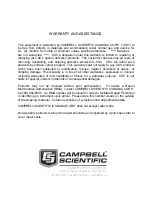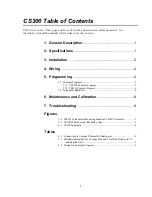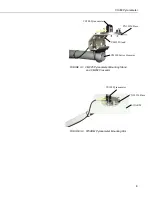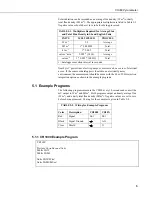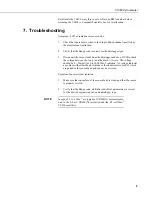
CS300 Pyranometer
1. General Description
The CS300 measures incoming solar radiation with a silicon photovoltaic
detector mounted in a cosine-corrected head. Output from the detector is a
current, which is converted to voltage by a potentiometer potted in the sensor
head. The resistance of the potentiometer is adjusted when the sensor is
calibrated so that all sensors have the same output sensitivity.
The CS300 is calibrated against a Kipp and Zonen CM21 under natural
sunlight to accurately measure sun plus sky radiation (300 to 1100 nm). The
CS300 should not be used under vegetation or artificial lights.
During the night the CS300 may read slightly negative incoming solar
radiation. This negative signal is caused by RF noise passing through the
photo-diode. Negative values may be set to zero in the datalogger program.
For more theoretical information on the silicon photovoltaic detector see Kerr,
J. P., G. W. Thurtell, and C. B. Tanner: An integrating pyranometer for
climatological observer stations and mesoscale networks. J. Appl. Meteor., 6,
688-694.
2. Specifications
Power requirements:
none, self-powered
Absolute accuracy:
±5% for daily total radiation
Cosine response:
±4% at 75° zenith angle
±1% at 45° zenith angle
Temperature response:
<1% at 5° to 40°C
Long-term stability:
<2% per year
Operating temperature:
-40° to +55°C
Relative humidity:
0 to 100%
Output:
0.2 mV per W m
-2
Dimensions:
0.9" (2.4 cm) diameter, 1.0" (2.5 cm) height
Weight:
2.3 oz (65 g) with 2 m lead wire
Measurement range:
0 to 2000 W m
-2
(full sunlight
|
1000 W m
-2
)
Light spectrum waveband: 300 to 1100 nm
The black outer jacket of the cable is Santoprene
®
rubber. This
compound was chosen for its resistance to temperature extremes,
moisture, and UV degradation. However, this jacket will
support combustion in air. It is rated as slow burning when
tested according to U.L. 94 H.B. and will pass FMVSS302.
Local fire codes may preclude its use inside buildings.
NOTE
1


